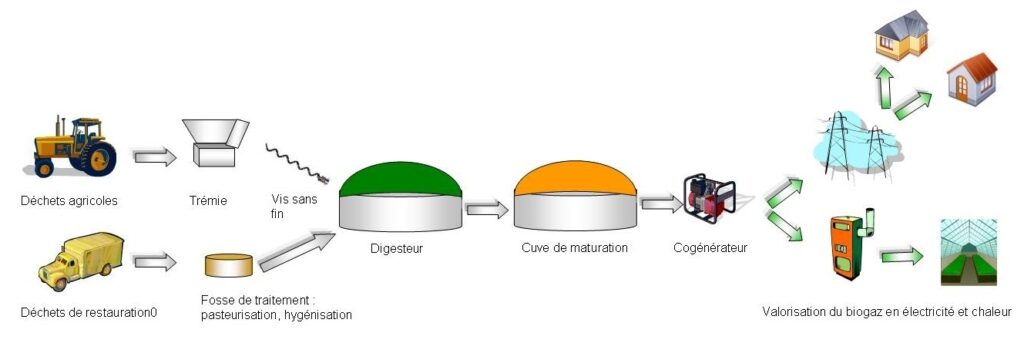Biogas, produced by the anaerobic digestion of organic waste, offers an ecological and local alternative to fossil natural gas. Used to generate electricity, heat, and fuel, it significantly reduces CO2 emissions and promotes more sustainable waste management. This article explores the advantages of biogas, its production process, its applications, and the future prospects of this renewable energy.
What is biogas?
Biogas is a renewable gas derived from the fermentation of organic materials such as agricultural waste, livestock manure, food scraps, and wastewater sludge. This process, called anaerobic digestion, occurs in the absence of oxygen, thanks to the action of microorganisms that break down organic matter, producing a mixture of methane (CH4) and carbon dioxide (CO2).
The advantages of biogas
Biogas offers numerous advantages. First, it allows for the valorization of organic waste that would otherwise be sent to landfills, thus limiting the greenhouse gas emissions associated with their decomposition. Next, it produces local and renewable energy, thereby reducing dependence on fossil fuels and increasing energy security. Furthermore, using biogas as fuel or for electricity and heat production can reduce CO2 emissions by up to 80% compared to traditional energy sources.
The biogas production process
The anaerobic digestion process begins with the collection of organic materials. These materials are then introduced into a digester, where they are broken down by microorganisms in an anaerobic environment. This process generates raw biogas, which mainly contains methane and carbon dioxide. This gas can be directly used for electricity or heat production or purified to obtain biomethane, a substitute for natural gas, which can be used in gas networks or as fuel for vehicles.
The applications of biogas
Biogas can be used in various ways. Firstly, it can be burned to produce electricity through electric generators. Next, it can be used in boilers to produce heat for buildings or industrial facilities. Finally, after purification, biomethane can be injected into natural gas networks or used as fuel for vehicles, thereby providing greener mobility.
Constraints and challenges
Despite its many advantages, biogas faces several challenges. Collecting and transporting organic materials can be logistically and financially demanding. Additionally, anaerobic digestion facilities require significant initial investments and rigorous technical management. Finally, there is the issue of managing digestate, the solid residues from anaerobic digestion, which must be methodically treated and recycled.
The future prospects of biogas
In the context of energy transitions and the fight against climate change, biogas has a crucial role to play. Numerous public policies now support the development of this sector by offering subsidies and tax incentives. With the improvement of anaerobic digestion technologies and an increasing demand for renewable energy, biogas could become an essential component of future energy systems, contributing to a circular economy and significantly reducing CO2 emissions.
In conclusion, biogas represents a promising renewable energy with multiple environmental and economic benefits. By valorizing organic waste to produce local and clean energy, it offers a viable and sustainable solution for the future energy landscape of our planet.
Articles similaires
Thank you!
We will contact you soon.













